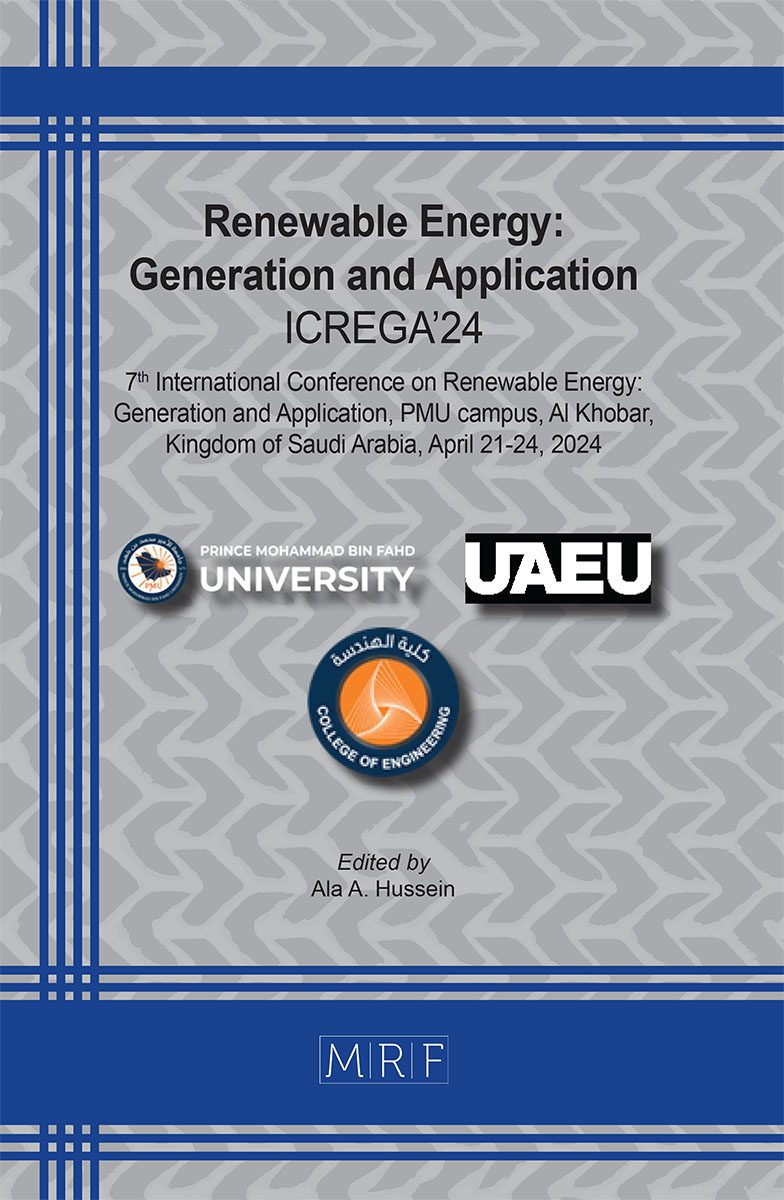–
Role of renewable energy in decarbonisation process: Case study in KSA
Samar DERNAYKA, Saidur R. CHOWDHURY, Mohammad Ali KHASAWNEH
download PDFAbstract. Currently, most countries are replacing the fossil fuel electricity generation with renewable technologies for their crucial role in mitigating the greenhouse gas emissions. This paper discusses the implementation of three power plants in Al Aziziya in the eastern province of KSA by deploying three different renewable technologies 1) Photovoltaic 2) Solar thermal power and 3) Wind turbine. Both the energy performance and rate of electricity exported to grid were predicted when the capacity varies from 1000 to 1000,000 KW. In addition, the role of the three different renewable technologies in the decarbonization process has been evaluated.
Keywords
Renewable, Wind Turbine, Photovoltaic, Solar, Carbon Emissions
Published online 7/15/2024, 9 pages
Copyright © 2024 by the author(s)
Published under license by Materials Research Forum LLC., Millersville PA, USA
Citation: Samar DERNAYKA, Saidur R. CHOWDHURY, Mohammad Ali KHASAWNEH, Role of renewable energy in decarbonisation process: Case study in KSA, Materials Research Proceedings, Vol. 43, pp 307-315, 2024
DOI: https://doi.org/10.21741/9781644903216-40
The article was published as article 40 of the book Renewable Energy: Generation and Application
![]() Content from this work may be used under the terms of the Creative Commons Attribution 3.0 license. Any further distribution of this work must maintain attribution to the author(s) and the title of the work, journal citation and DOI.
Content from this work may be used under the terms of the Creative Commons Attribution 3.0 license. Any further distribution of this work must maintain attribution to the author(s) and the title of the work, journal citation and DOI.
References
[1] O. Edenhofer, R. P. Madruga, Y. Sokona, Renewable Energy Sources and Climate Change Mitigation, Cambridge University Press, New York, USA, 2012. ISBN 978-1-107-60710-1.
[2] R. Gh. Alajmi, Factors that impact greenhouse gas emissions in Saudi Arabia: Decomposition analysis using LMDI, Energy Policy 156 (2021) , 112454. https://doi.org/10.1016/j.enpol.2021.112454
[3] M. Aldubyan, M. Krarti,, & E. Williams, Residential Energy Model for Evaluating Energy Demand and Energy Efficiency Programs in Saudi Residential Buildings, (2020) KAPSARC, Riyadh, KSA. https://doi.org/10.30573/KS–2020-MP05
[4] F. Alrashed, & M. Asif, Trends in residential energy consumption in Saudi Arabia with particular reference to the Eastern Province. Journal of Sustainable Development of Energy, Water and Environment Systems, 2(4) (2014), 376-387. https://doi.org/10.13044/j.sdewes.2014.02.0030
[5] https://www.anker.com/blogs/home-power-backup/electricity-usage-how-much-energy-does-an-average-house-use
[6] M. Gul, Y. Kotak, & T. Muneer, Review on recent trend of solar photovoltaic technology. Energy Exploration & Exploitation, 34(4), (2016), 485-526. https://doi.org/10.1177/0144598716650552
[7] N. A. Ludin, N. I. Mustafa, M. M. Hanafiah, M. A. Ibrahim, M. A. Teridi, M. Sepeai & K. Sopian, Prospects of life cycle assessment of renewable energy from solar photovoltaic technologies: A review. Renewable and Sustainable Energy Reviews, 96 (2018) 11-28. https://doi.org/10.1016/j.rser.2018.07.048
[8] R. Gh. Alajmi, Carbon emissions and electricity generation modeling in Saudi Arabia. Environmental Science and Pollution Research (2022) 29:23169–23179. https://doi.org/10.1007/s11356-021-17354-0
[9] C. D. Gielena , F.Boshella , D. Sayginb , M. D. Bazilianc , N. Wagnera, R. Gorini, The role of renewable energy in the global energy transformation, Energy Strategy Reviews 24 (2019) 38 -50. https://doi.org/10.1016/j.esr.2019.01.006
[10] D. Saygin, M. Hoffman, P. Godron, How Turkey Can Ensure A Successful Energy Transition, Center for American Progress, Washington, DC, 2018.
[11] CLEAN ENERGY PROJECT ANALYSIS: RETSCREEN® ENGINEERING & CASES TEXTBOOK, Minister of Natural Resources Canada 2001-2005, ISBN: 0-662-39191-8 Catalogue no.: M39-112/2005E-PDF
[12] P. K. Nayak, S. Mahesh, H. J. Snaith, & D. Cahen, Photovoltaic solar cell technologies: analysing the state of the art. Nature Reviews Materials, 4(4) (2019) 269-285. https://doi.org/10.1038/s41578-019-0097-0
[13] N. Rathore, N. L. Panwar, F. Yettou, & A. Gama, A comprehensive review of different types of solar photovoltaic cells and their applications. International Journal of Ambient Energy, 42(10) (2021) 1200-1217. https://doi.org/10.1080/01430750.2019.1592774
[14] A. R. Jordehi, Parameter estimation of solar photovoltaic (PV) cells: A review. Renewable and Sustainable Energy Reviews, 61(2016) 354-371. https://doi.org/10.1016/j.rser.2016.03.049
[15] A. A. H. Hussein, S. Harb, N. Kutkut, J. Shen, & I. Batarseh, Design considerations for distributed micro-storage systems in residential applications. In Intelec 2010 (pp. 1-6). IEEE. https://doi.org/10.1109/INTLEC.2010.5525658
[16] G. K. Singh, Solar power generation by PV (photovoltaic) technology: A review. Energy 53 (2013) 1-13. https://doi.org/10.1016/j.energy.2013.02.057
[17] S. A Kalogirou, Solar thermal collectors and applications. Progress in Energy and Combustion Science 30 (2004) 231–295. https://doi.org/10.1016/j.pecs.2004.02.001
[18] L. Kumar, J. Ahmed, M.E. H. Assad, M. Hasanuzzaman. Prospects and Challenges of Solar Thermal for Process Heating: A Comprehensive Review. Energies 2022, 15, 8501. https://doi.org/10.3390/en15228501
[19] T. Merrigan. Solar Energy Technologies. National Renewable Energy Laboratory, U.S. Department of Energy. 2005. /https://www1.eere.energy.gov/solar/pdfs/solar_tim_merrigan.pdf
[20] A. G. Lupu, V. M. Homutescu, D. T. Balanescu, and A. Popescu, Efficiency of solar collectors – a review. IOP Conf. Series: Materials Science and Engineering 444 (2018) 082015. https://doi.org/10.1088/1757-899X/444/8/082015
[21] D. Song, Y. Yang, S. Zheng, W. Tang, J. Yang, M. Su, X. Yang, J. Y. Hoon, Capacity factor estimation of variable-speed wind turbines considering the coupled influence of the QNcurve and the air density, Energy, Vol. (183) (2019) pp 1049 – 1060. https://doi.org/10.1016/j.energy.2019.07.018
[22] Y. El Khchin, M. Sriti, Performance Evaluation of wind turbines for energy production in Morocco’s coastal regions. Results in Engineering 10 (2021) 100215. https://doi.org/10.1016/j.rineng.2021.100215
[23] U.S. Energy Information Administration (EIA), Electricity generation from wind. 1000 Independence Ave., SW Washington, DC 20585 (2022) https://www.eia.gov/energyexplained/wind/electricity-generation-from-wind












